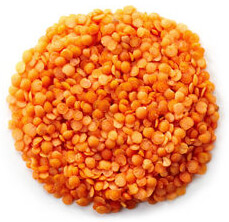In previous articles we’ve compared the differences between various types of lentils as it relates to their nutritional profile. Today, however, we’ll be focusing on all of the differences between red lentils vs green lentils — and not just their nutrition facts either. We’ll be going over all of their differences, including taste, texture, and use.
In short, the nutritional difference between red lentils vs green lentils is minimal. They each contain a similar amount of calories, carbs, protein, fat, vitamins, and minerals. The biggest difference between the two is their taste and texture, with the red variety having a mushier consistency and sweeter taste.
Let’s examine these details further.
What Are Red Lentils?
Red lentils are tiny lens-shaped seeds that are orange-red in color, and are most commonly used in Indian cuisine and recipes that include curry or daal.

Originally grown in southwest Asia, red lentils differ from ordinary lentils in appearance– and not just because of their color.
Once harvested and packaged, red lentils do not contain their outer skin as green lentils do. Instead, the skin is removed during the dehulling process. They often come “split” as well, meaning they’ve been cut in half. This helps to reduce their cooking time as it makes them less dense.
What Are Green Lentils?
“Green” lentils are the ordinary type of lentil that is used in lentil soup. Much like red lentils, they too are tiny lens-shaped seeds. However, they are earthy-green in color and can sometimes vary in shades of brown.

One of the more noticeable differences between red lentils vs green lentils is their outer casing. Unlike red lentils, green lentils come in whole seed form with their outer hull still intact.
This impacts their cooking time as the skin has an insulating effect. Furthermore, green lentils aren’t split like red lentils are, and are therefore denser and contain less surface area.
Red Lentils VS Green Lentils
Now that we have a basic understanding of what red and green lentils are, let’s have a look at all of the ways in which they differ– starting with the nutrition facts.
Nutritional Differences
The table below compares the nutrition facts of a dry 1/4 cup serving of both red lentils and green lentils:
| Item | Red Lentils | Green Lentils |
| Serving Size | 1/4 cup, dry | 1/4 cup, dry |
| Calories | 190 | 170 |
| Total Carbohydrates | 33g | 31g |
| Sugar | 1g | 1g |
| Fiber | 7g | 8g |
| Total Fat | 0.5g | 1g |
| Saturated Fat | 0g | 0g |
| Protein | 12g | 11g |
| Sodium | 0mg | 5mg |
| Potassium | 500mg | 430mg |
| Iron | 3mg | 3.1mg |
As you can see, both red and green lentils are nearly identical in terms of nutrition. They’re both excellent sources of protein, fiber, and potassium. What’s more, lentils (of all types) come with many health benefits. According to Harvard School Of Public Health, human studies have found that lentils can help improve cholesterol levels and protect against certain types of cancers.
Protein
When it comes to protein, there is virtually no difference between red lentils vs green lentils.
Legumes (such as lentils) are unique in that they are plant-based foods that are high in protein– a characteristic that is typically only true of animal-based foods.
Protein is an essential macronutrient that is made up of amino acids. Your body uses protein for countless processes, including metabolism and the building and repair of muscle tissue. This makes protein especially important for athletes and gym enthusiasts alike.
Those following vegan, vegetarian, or plant-based diets that exclude meat often struggle to reach their protein goals. This is because most plant-based foods — such as fruits, vegetables, and grains — tend to be carb-heavy, with roughly 80% of their calories coming from carbohydrates.
Although lentils don’t quite have as much protein as beans, they have a much shorter cook time, making them a more convenient choice.
Fiber
Not only are red and green lentils excellent sources of protein, but they pack plenty of fiber too!
An indigestible carbohydrate that the body uses to remove waste, fiber consumption is associated with various health benefits.
According to Mayo Clinic, dietary fiber intake can:
- Help normalize bowel movements
- Lower cholesterol
- Control blood sugar
- Aid in weight loss
When opting for red lentils vs green lentils you’ll be getting slightly less fiber per serving, as a 1/4 cup serving contains 7 grams. Green lentils, on the other hand, contain 8 grams of fiber for the same serving size. Both varieties are clearly good sources of fiber either way, though,
Potassium
Potassium is an essential electrolyte and mineral that the body uses to control the electrical pulses in the body. It is also responsible for muscle contraction, fluid balance, and various other processes.
Possibly the greatest benefit potassium has to offer is its ability to normalize blood pressure, according to the Harvard Health Publishing website.
Those seeking to boost their potassium intake will be happy to hear that both red and green lentils are excellent sources of it, as a 1/4 cup dry serving of each will provide you with 500 mg and 430 mg of potassium respectively.
Taste & Texture
Let’s examine the differences between red lentils vs green lentils through the lens of what you can expect when eating them.
As far as taste goes, red lentils are described as having a mild, earthy flavor; but somewhat sweeter than green lentils.
Since red lentils are hulled — as opposed to green lentils, which still have their skin intact — they break down into a mushy consistency that can be used for soups, sauces, daal, and curry dishes.
Green lentils, on the other hand, don’t break down like red lentils do when cooked. They soften quite a bit and have a mushy consistency of their own once eaten, but their outer hull keeps them more firm and in their whole seed form.
The taste of green lentils, compared to red lentils, can be described as earthy, but less sweet and more peppery.
Cooking & Preparation
Now let’s have a look at the differences in prep time between red and green lentils.
To cook green lentils:
- Rinse them off to remove any unwanted dirt or debris
- Place 3 parts water to 1 part lentils in a pot and bring it to a boil
- Once boiling, reduce heat, cover and let simmer for roughly 45 minutes
Red lentils, on the other hand, are cooked using a similar process. However, the cooking time is greatly reduced as they break down much quicker than green lentils do.
The following video tutorial from the Lentils.org YouTube channel demonstrates how to cook both green and red lentils:
How They Can Be Used
One area where there’s a pretty big difference between red lentils vs green lentils is how they’re used.
Although they’re both nearly identical in terms of nutrition, their differences in taste, texture, and consistency set them apart in how they’re most commonly used.
The creamy consistency of red lentils, once cooked, makes them ideal for:
- Curry
- Daal
- Sauces
- Soups
Furthermore, red lentils are used to make red lentil pasta— a gluten-free pasta alternative with many more benefits.
Green lentils, on the other hand, are commonly:
- Added to soups
- Used in chili recipes
- Used to make Mediterranean salads
- Served with rice
It should also be noted that green lentils can be used as a substitute for beans and peas in many dishes.
How They Can Be Grown
Now that we know all of the differences between these two lentil types, let’s address whether or not there’s a difference in how to grow them.
As it turns out, both red and green lentils grow under similar conditions.
According to the HeartBeet website, lentils grow well in areas of limited rainfall and are typically harvested mid-August. They will grow in all soil types with good drainage, but loam soil is recommended.
Lentils grow in pods and are harvested dry.
The Bottom Line
In conclusion, there are many differences between red lentils vs green lentils. They look different, they taste different, and they’re used in different ways. That said, they’re both quite similar where it matters– their nutritional profile.
Seeing as how both red and green lentils are excellent nutritional sources with various health benefits, this choice simply boils down (pun intended) to personal preference.

